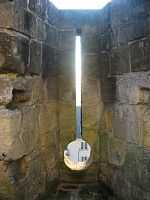Embrasure



In military architecture, an embrasure is the opening in a crenellation or battlement between the two raised solid portions or merlons, sometimes called a crenel or crenelle. In domestic architecture this refers to the outward splay of a window or arrow slit on the inside.
A loophole, arrow loop or arrow slit passes through a solid wall and was originally for use by archers. The purpose of embrasures is to allow weapons to be fired out from the fortification while the firer remains under cover. The splay of the wall on the inside provides room for the soldier and his equipment, and allows them to get as close to the wall face and arrow slit itself as possible. Excellent examples of deep embrasures with arrow slits are to be seen at Aigues-Mortes and Château de Coucy, both in France.
History
The etymology of embrasure expresses "widening".
The invention of the arrowslit is attributed to Archimedes during the siege of Syracuse in 214–212 BC.
From Polybius's (c. 200–118 BC) The Histories:
[Archimedes] had had the walls pierced with large numbers of loopholes at the height of a man, which were about a palm's breadth wide at the outer surface of the walls. Behind each of these and inside the walls were stationed archers with rows of so-called "scorpions", a small catapult which discharged iron darts, and by shooting through these embrasures they put many of the marines out of action.[citation needed]
However the invention was later forgotten until reintroduced in the 12th century. See arrowslit.
By the 19th century, a distinction was made between embrasures being used for cannon, and loopholes being used for musketry. In both cases, the opening was normally made wider on the inside of the wall than the outside. The outside was made as narrow as possible (slightly wider than the muzzle of the weapon intended to use it) so as to afford the most difficult possible shot to attackers firing back, but the inside had to be wider in order to enable the weapon to be swiveled around so as to aim over a reasonably large arc.
Variations
A distinction was made between horizontal and vertical embrasures or loopholes, depending on the orientation of the slit formed in the outside wall. Vertical loopholes—which are much more common—allow the weapon to be easily raised and lowered in elevation so as to cover a variety of ranges easily. However to sweep from side to side the weapon (and its firer or crew) must bodily move from side to side to pivot around the muzzle, which is effectively fixed by the slit. Horizontal loopholes, on the other hand, facilitate quick sweeping across the arc in front, but make large adjustments in elevation very difficult. They were usually used in circumstances where the range was very restricted anyway, or where rapid cover of a wide field of arc was preferred.
Another variation had both horizontal and vertical slits arranged in the form of a cross, and was called a crosslet loop or an arbalestina since it was principally intended for arbalestiers (crossbowmen). In the sixteenth and seventeenth centuries, after the crossbow had become obsolete as a military weapon, crosslet loopholes were still sometimes created as a decorative architectural feature with a Christian symbolism.
A stepped embrasure was often utilized on pillbox bunkers of the 20th century, allowing for a relatively wide field of fire compared to a traditional embrasure while also minimizing the shot trap phenomenon created by the sloped opening. A series of perpendicular "steps" tapering to the gun port ensured that any incoming fire would be stopped by a vertical impact and not funneled inward towards the slit.
See also
References
-
 This article incorporates text from a publication now in the public domain: Chisholm, Hugh, ed. (1911). Encyclopædia Britannica (11th ed.). Cambridge University Press
This article incorporates text from a publication now in the public domain: Chisholm, Hugh, ed. (1911). Encyclopædia Britannica (11th ed.). Cambridge University Press
External links
| Wikimedia Commons has media related to Embrasures. |
| ||||||||||||||||||||